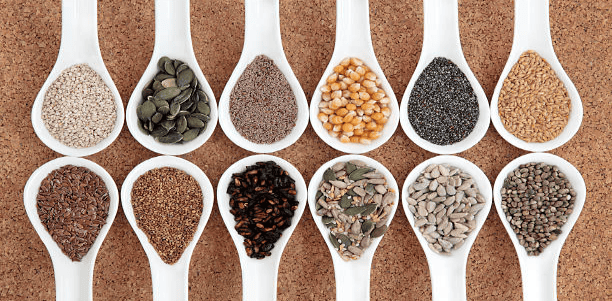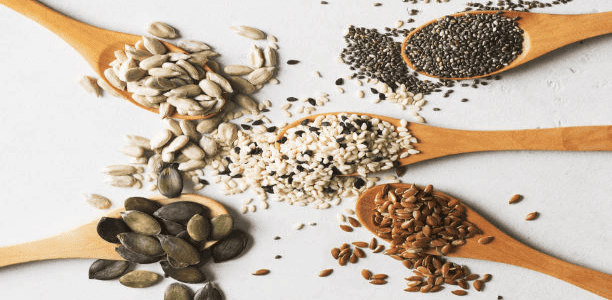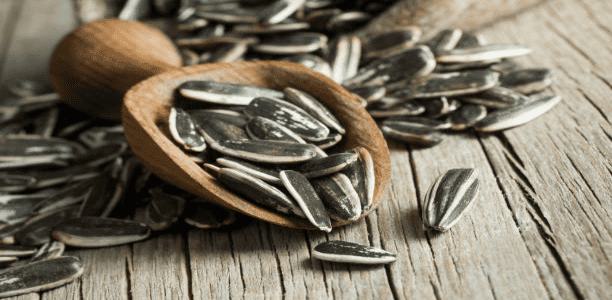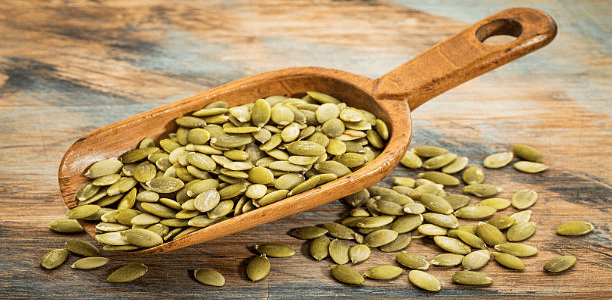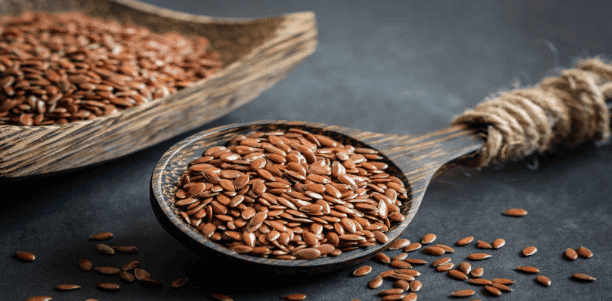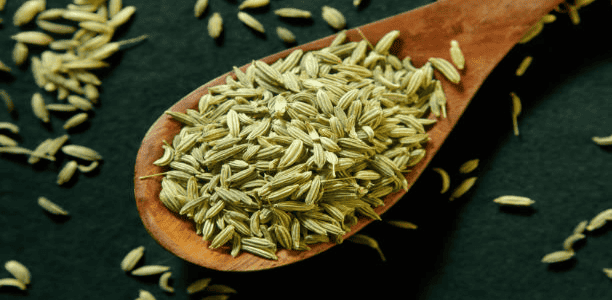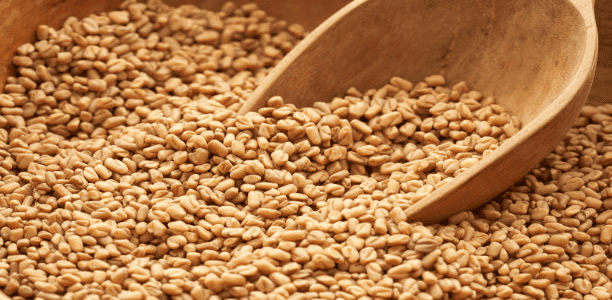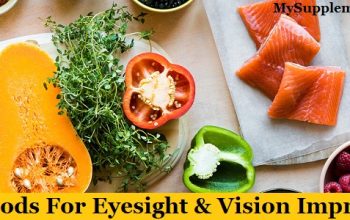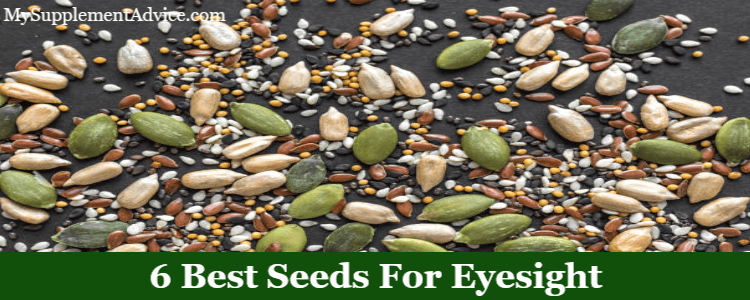
Let's talk about the 6 best seeds for eyesight.
You've probably heard about all the benefits certain seeds can bring to your eyes.
And maintaining a healthy vision should be one of your top priorities.
So let's see how incorporating these seeds into your daily diet could help.
Note: This article includes references and studies on seeds and eyesight.
Best Seeds For Eyesight (In A Nutshell)
So in this article, we talked about the 6 best seeds for eyesight.
Although there are numerous varieties out there, we focused on the ones that are more accessible.
With that, here's a quick summary of the seeds featured down the line:
- chia seeds
- pumpkin seeds
- sunflower seeds
- fennel seeds
- flax seeds
- fenugreek seeds
In essence, seeds are one of the top sources of omega-3 fatty acids.
Also – they are abundant in antioxidants, minerals and vitamins for eyesight.
As we all know, these compounds are proven to promote long-term eye health:
- reduce age-related and UV-related damage
- lower the risk of eye diseases and infections
- help different parts of the eyes to function normally
- strengthen the cornea and retina
- increase visual awareness and vision in low-light settings
You can also find below some easy ways to incorporate them into your daily routine.
As long as you're familiar with their aromas and taste, you can find the right recipes that will suit your preferences.
You won't only enjoy their flavors, but you will also reap their nutritional benefits at the same time.
However – it's also important to note that relying solely on these seeds may not have the optimal results.
So it's best to integrate them into a well-balanced diet.
Also – it's important to include other top foods for vision improvement (that are also rich in omega-3).
To make the most of their benefits, you might also want to try a good eye supplement.
Lastly – you must understand that these seeds are not an actual treatment for any eye issues.
But rather, consider them as additional sources of nutrients for your eyes.
Seeds & Eyesight
There are a lot of food groups that offer benefits in vision improvement.
But in this article, let's give a spotlight on the best seeds that are worth adding to your pantry:
- chia seeds
- sunflower seeds
- pumpkin seeds
- flax seeds
- fennel seeds
- fenugreek seeds
So what makes them essential for eye health?
Well, they are rich in Omega-3 fatty acids, antioxidants, vitamins and minerals [1].
To give you more insight, here are some essential nutrients present in all the seeds below:
- α-linoleic acid (ALA), docosahexaenoic acid (DHA) and eicosapentaenoic acid (EPA)
- vitamins A, C, E, B6, niacin and folate
- potassium, magnesium, calcium and zinc
- β-carotene, lutein and zeaxanthin
Just so you know, these compounds are important in several pathways responsible for eye function.
When they all work together, you can expect several benefits:
- prevent age-related macular degeneration (AMD) [2]
- reduce the risks of dry eye syndrome, cataracts and glaucoma
- maintain eyes' cell membranes [3]
- support retinal functions and visual awareness
- offer protection against harmful UV radiation and oxidative stress
- strengthen the cornea and other eye tissues [4]
- improve vision during low-light conditions
Most seeds are called superfoods (due to these factors).
Additionally, only a few food sources contain omega-3 fatty acids.
With that – it's very important to consume them in sufficient amounts.
However – keep in mind that the seeds alone don't contain enough omega-3 to make a huge difference for your eyesight.
So it's very important to include other food into your diet (like fish).
Now, let's take a close look at the most important seeds you could take for your vision.
#1 – Chia Seeds
Let's start by looking at the chia seed's profile [5]:
- comes from the plant Salvia hispanica (mint family Lamiaceae)
- native to central and southern Guatemala and Mexico
- best described as tiny, oval-shaped, smooth texture and black/white/gray colored seeds
- very mild nutty taste
In terms of nutrients, chia seeds are a source of fiber, protein and phosphorus.
Additionally – it's a versatile culinary ingredient, due to its tiny size and faint taste.
With that, here are some easy ways to include them into your diet:
- Create a chia seed pudding by soaking the seeds in milk and adding a natural sweetener.
- Amplify your smoothie recipe by incorporating 1-2 tablespoons of chia seeds.
- Consider adding chia seeds to your mashed fruits and make a jam.
- Make some energy balls by rolling oats, nut butter, natural sweetener and chia seeds.
- Mix the chia seeds with olive oil, lemon juice and spices to make a salad dressing.
- Lastly, you can use chia seeds as all-around sprinkles or toppings.
As you can see, you can add the seeds to almost any recipe (may it be a dish, juice or even in plain water).
They can surely elevate the nutritional value of your foods and drinks.
Not only that, but you can also get a decent amount of omega-3 to protect your eyes.
So if you don't like the taste of typical seeds, then chia is the right option for you.
Their flavor isn't too significant or noticeable.
Overall – they make the perfect food addition for people who want to keep their eyes healthy.
#2 – Sunflower Seeds
The next seed that we're going to feature in this article is sunflower.
So far – here's the basic info you might want to know about it [6]:
- comes from the aster family called Asteraceae and its scientific name is Helianthus annuus
- the herbaceous plant is predominant in North and South America
- physically, it can be described as a broad, cylindrical or drop-shaped seed with white/black stripe colors
- just like chia seeds, it also has a mild and nutty flavor
Apart from the nutrients above, it also contains iron, selenium and phosphorus.
As we all know, these minerals prevent several eye-related diseases.
Typically – sunflower seeds can be eaten roasted or raw, as a standalone snack.
But you can also get creative – and let me give you some ideas:
- Sprinkle them on top of salads for added flavor and crunch.
- Add them to your home-baked goodies (muffins, bread, etc.).
- Combine them with dried fruits, nuts and dark chocolate to create a trail mix.
- Make a sunflower seed butter spread/dip by roasting and blending the seeds.
- Crush the seeds and use them as a coating for baked fish or chicken.
Based on the examples above, sunflower seeds will surely add flavor and texture to your food.
They can add a unique twist to your dish and turn it to another level.
Not to mention the essential nutrients they contain.
#3 – Pumpkin Seeds
The third seed that we're going to talk about is the pumpkin seed.
Obviously – it comes from pumpkin (Cucurbita maxima).
But in addition to that, here are some of the basic facts about it [7]:
- the plant comes from the Cucurbitaceae family (together with watermelon, cucumber and cantaloupe)
- is originated in Mexico and in North America
- has a white outer husk, light green content and oval in shape
- when it comes to taste, it's more on the savory and earthy side
Again – it's a healthy seed, so it contains the basic nutrients needed by the eyes.
Besides, it's also rich in fiber, phosphorus and selenium.
So what are the different ways to enjoy pumpkin seeds?
Well – here are some examples that you might find useful:
- You can try roasted plain or naturally-seasoned pumpkin seeds for snacking.
- You can also use them as soup toppings for additional texture.
- They can also be added into a trail mix or homemade granola.
- You can garnish your favorite salad or grain bowls with the seeds.
- Try blending 1-2 teaspoons into your smoothie or protein shake.
At first, you might think that pumpkin seeds are a small addition to your meals.
But in reality, they're not only crunchy, but they also bring a lot of eye benefits.
In fact – a lot of people believe that pumpkin is one of the top vegetables for eye health.
So the next time you're out of snack ideas, pumpkin seeds are a great option.
They will not only fill your stomach – but they will also help you boost your eyesight.
#4 – Flax Seeds
Firstly – flax seed is also called linseed and it has been present for hundreds of years.
So with that, here are the general info about it [8]:
- extracted from flax plants (Linum usitatissimum from the Linaceae family)
- native to West Asia, Mediterranean coastal lands and other parts of Europe
- a lot of people describe its taste as slightly sweet with an earthy or nutty flavor
- has a similar look with sesame seeds (but it's more elongated and brown-colored)
Now – flax seed is known to be high in Omega-3 (specifically ALA).
Just so you know, this type of fatty acid works by controlling eye disorders.
In addition to that, flax seeds are also abundant in fiber and proteins.
For this reason, a lot of people try to consume them whenever they can.
To give you an idea, here are several ways to make the most out of flax seeds:
- Add a nutritional boost to your smoothie by blending the ingredients with flax seeds.
- Whisk your ground flax seeds into your homemade salad dressings.
- Use them as an egg substitute for baking by mixing the ground seeds with water.
- You can also load up your baked goodies or oatmeal with fiber by incorporating ground flax seeds.
- Sprinkle flax seeds on top of your gelato or yogurt.
Honestly, flax seeds are popular with people who are health conscious and want to improve their digestion.
Well – they have the right reasons…
But as I mentioned, flax seeds are very very beneficial for the eyes due to their ALA content.
#5 – Fennel Seeds
Another plant product you need to consider is fennel seed.
But before telling you why, let's first take a look at it [9]:
- its scientific name is Foeniculum vulgare and it belongs to the carrot family (Apiaceae)
- was first discovered in Southern Europe and Southwestern Asia
- its taste resembles star anise but it's slightly milder
- in terms of physical appearance, its color is pale green to tan and has a slim oval shape
A lot of studies were conducted to discover its nutritional composition.
So according to them, its most abundant nutrient is potassium [10].
In fact – it's one of the highest plant sources in this mineral.
To emphasize, potassium is one of the components of our eye's tear film [11].
With that being said, consuming fennel seeds can contribute to preventing dry eyes.
Now – there are some people who don't like their taste or aroma.
But let me give you some suggestions to make them more enjoyable for consumption:
- Make a herbal tea by steeping the seeds in hot water.
- Grind or crush the fennel seeds and use them as spice in rubs, curries or marinades.
- You can also put them in your pickle recipes (for some aromatic twists).
- Add the seeds to your roasted dishes like vegetables or fish to enhance their flavors.
- Make a fennel seed-infused butter or olive oil and use them in your salad dressing or bread spread.
Unlike the other seeds mentioned above, fennel seeds have a stronger scent and taste.
So it's quite understandable why not everybody likes them.
However – don't forget that it's rich in potassium which is important for our eyes.
With that, you just have to find the proper ways to use them.
#6 – Fenugreek Seeds
Lastly – fenugreek seed is also a popular seed advantageous for the eyes.
With that, let's quickly give a rundown on some of its top details [12]:
- fenugreek is native to the Mediterranean region and southern Europe
- comes from the pea family (Fabaceae) and its scientific name is Trigonella foenum-graecum
- fenugreek seed's taste is more on the sweet and nutty side
- can be described as semi-flat, irregularly shaped and yellow-brown colored seeds
According to some research, fenugreek seeds contain plenty of eye-essential nutrients.
Some of them include nicotinic acid and vitamins B1 and B2 [13].
Also, there's choline, which is involved in retina development and maintenance [14].
Now – how are you going to maximize its sweet-nutty flavor?:
- Create sprouted fenugreek by soaking the seeds in water then harvest the sprouts after 4-6 days.
- Steep the crushed seeds in hot water and consume the infusion like any other tea.
- Powder the seeds and use them as part of your spice blend.
- Add a distinctive taste to your soups, stews or vegetable dishes by sprinkling a small amount of the seeds.
Overall – fenugreek seeds came to fame not only because of their taste, but also due to their effects on the eyes.
Plus, they are not really hard to incorporate into your dishes.
So I highly suggest that you try to add fenugreek seeds the next time you're preparing your meal.
Final Conclusion
To summarize, these seeds are high in omega-3 fatty acids.

Additionally – they also contain valuable compounds like vitamins, minerals and antioxidants.
With that being said, we talked about the best seeds for eyesight in this article:
- chia
- sunflower
- pumpkin
- flax
- fennel
- fenugreek
As we all know, there are still a lot of potential seeds out there.
But the ones listed above are the top ones you can easily find.
Now – I also gave you some examples of how to include them in your everyday routine.
So depending on their taste profile, you can surely find the right recipes.
It's like hitting two birds with one stone – because you get the flavor and the nutrients all at once.
Overall – these seeds are small, but their benefits are mighty.
Also – I highly suggest that you also eat other foods that are high in omega-3 fatty acids (like fish).
Another way to boost these seeds' vision effect is by taking some high-quality eye supplements.
Lastly – these seeds are not a cure for any eye problems, so don't expect any miracles from them.
References:
1 – https://www.betterhealth.vic.gov.au/health/-nuts-and-seeds/
2 – https://pubmed.ncbi.nlm.nih.gov/-19227095/
3 – https://pubmed.ncbi.nlm.nih.gov/-15366399/
4 – https://www.ncbi.nlm.nih.gov/-pmc/articles/-PMC4165511/
5 – https://www.hsph.harvard.edu/-nutritionsource/-chia-seeds/
6 – https://www.researchgate.net/-publication/-275653985/
7 – https://www.britannica.com/-plant/-pumpkin/
8 – https://www.sciencedirect.com/topics/-linum-usitatissimum/
9 – https://www.sciencedirect.com/-topics/-foeniculum-vulgare/
10 – https://www.ncbi.nlm.nih.gov/-pmc/articles/-PMC4137549/
11 – https://www.sciencedirect.com/topics/neuroscience/-tear-film/
12 – https://www.britannica.com/-plant/-fenugreek/
13 – https://www.ncbi.nlm.nih.gov/-pmc/articles/-PMC4894452/
14 – https://www.ncbi.nlm.nih.gov/-pmc/articles/-PMC8124599/

